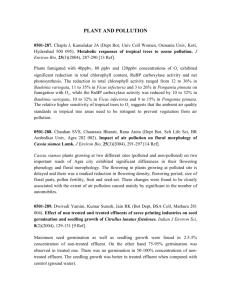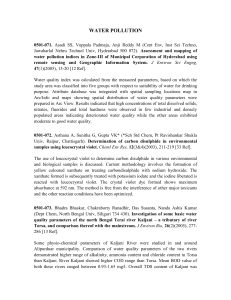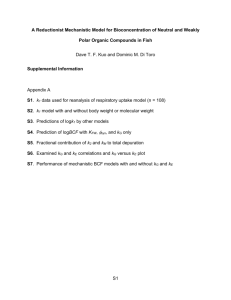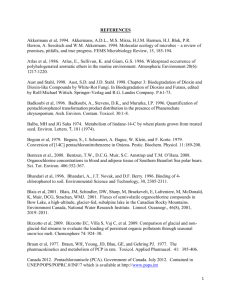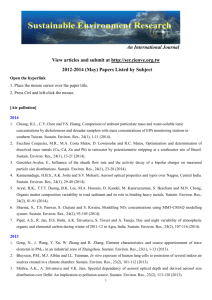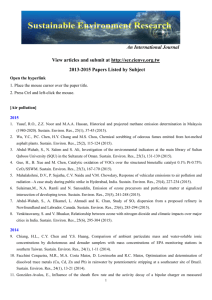Air Pollution
advertisement
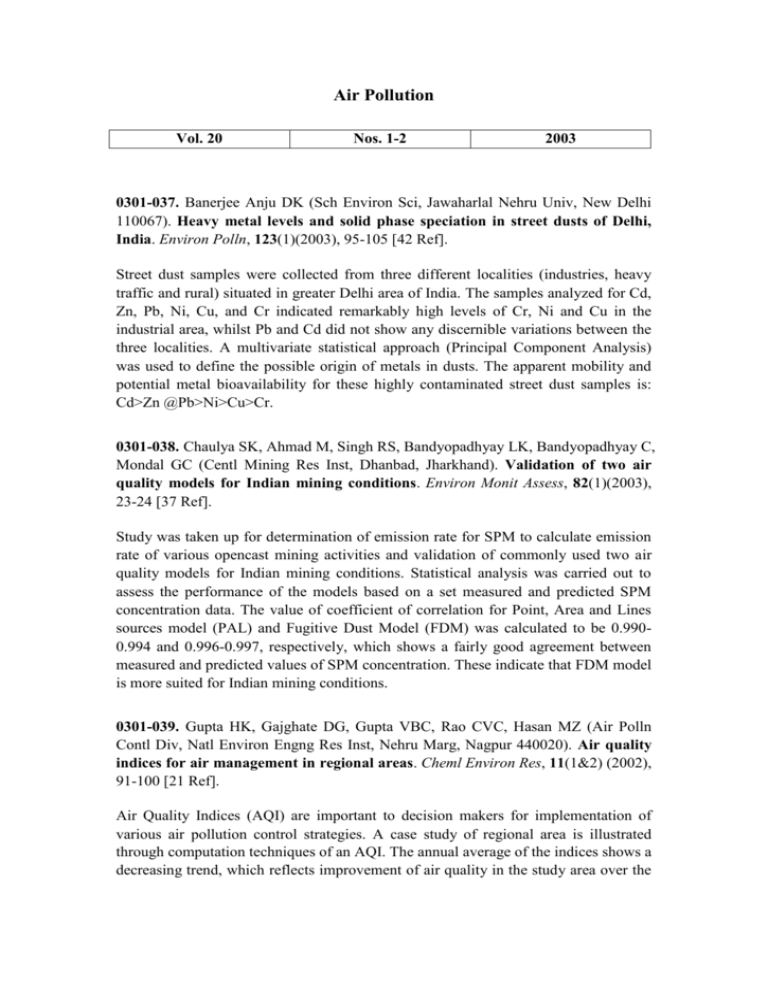
Air Pollution Vol. 20 Nos. 1-2 2003 0301-037. Banerjee Anju DK (Sch Environ Sci, Jawaharlal Nehru Univ, New Delhi 110067). Heavy metal levels and solid phase speciation in street dusts of Delhi, India. Environ Polln, 123(1)(2003), 95-105 [42 Ref]. Street dust samples were collected from three different localities (industries, heavy traffic and rural) situated in greater Delhi area of India. The samples analyzed for Cd, Zn, Pb, Ni, Cu, and Cr indicated remarkably high levels of Cr, Ni and Cu in the industrial area, whilst Pb and Cd did not show any discernible variations between the three localities. A multivariate statistical approach (Principal Component Analysis) was used to define the possible origin of metals in dusts. The apparent mobility and potential metal bioavailability for these highly contaminated street dust samples is: Cd>Zn @Pb>Ni>Cu>Cr. 0301-038. Chaulya SK, Ahmad M, Singh RS, Bandyopadhyay LK, Bandyopadhyay C, Mondal GC (Centl Mining Res Inst, Dhanbad, Jharkhand). Validation of two air quality models for Indian mining conditions. Environ Monit Assess, 82(1)(2003), 23-24 [37 Ref]. Study was taken up for determination of emission rate for SPM to calculate emission rate of various opencast mining activities and validation of commonly used two air quality models for Indian mining conditions. Statistical analysis was carried out to assess the performance of the models based on a set measured and predicted SPM concentration data. The value of coefficient of correlation for Point, Area and Lines sources model (PAL) and Fugitive Dust Model (FDM) was calculated to be 0.9900.994 and 0.996-0.997, respectively, which shows a fairly good agreement between measured and predicted values of SPM concentration. These indicate that FDM model is more suited for Indian mining conditions. 0301-039. Gupta HK, Gajghate DG, Gupta VBC, Rao CVC, Hasan MZ (Air Polln Contl Div, Natl Environ Engng Res Inst, Nehru Marg, Nagpur 440020). Air quality indices for air management in regional areas. Cheml Environ Res, 11(1&2) (2002), 91-100 [21 Ref]. Air Quality Indices (AQI) are important to decision makers for implementation of various air pollution control strategies. A case study of regional area is illustrated through computation techniques of an AQI. The annual average of the indices shows a decreasing trend, which reflects improvement of air quality in the study area over the years. The index values obtained for various areas are feed back for effective pollution control measures adopted for reduction of emissions from various sources. 0301-040. Gurumani V, Senthilvelan S, Ramajayam M, Ramanathan AR (Dept Chem, Annamalai Univ, Annamalainagar 608002). A study on smoke reduction in diesel engines through organic fuel additives. Asian J Chem, 15(1)(2003), 693-699 [9 Ref]. Some earlier studies on diesel engine emission control employing metallic additives are briefly reviewed. Considering the formation of undesirable toxic combustion products by the deposits left by the metallic additives, present study examined, rated and reported the smoke reduction characteristics of eight non-metallic organic compounds (one non-oxygenated and seven oxygenated). The effects of additive concentration and the engine load per cent are outlined. 0301-041. Padma S Rao B, Shrinivas Rao B, Manthapurwar NS, Hasan MZ (Air Polln Contl Div, Natl Environ Engng Res Inst, Nagpur). Flue gas treatability studies: A tool for techno-economic control of industrial air pollution. Environ Monit Assess, 82(1)(2003), 75-81 [5 Ref]. Article provides information about a novel technique known as flue gas treatability studies and to undertake such studies, a pilot scale system is installed in Air Pollution Control Division of M/s National Environmental Engineering Research Institute, NEERI, Nagpur. This study is a tool for techno-economic selection of air-pollution control systems specially for small/medium scale industrial emissions. 0301-042. Sachdeva Neha Som, Khanna DR (Dept Zoo Environ Sci, Gurukul Kangri Univ, Hardwar 249404). Analysis of some selected characteristics of air emissions from a fertilizer industry. Env Conserv J, 3(1)(2002), 25-29 [11 Ref]. Air is the most essential component of life and is required for the various activities in the biosphere thus it entails to protect our environment. The different parameters of air quality of stacks and ambient air stations were taken for the analysis and found within the permissible limits. By these results, it becomes a very important concept for every industry to check the pollution load and should minimize its after effects by installing proper treatment systems. 0301-043. Sharma Mukesh, Kiran YNVM, Shandilya Kaushik K (Environ Engng Manag Prog, Dept Civil Engng, Indian Inst Techno Kanpur, Kanpur 208016). Investigations into formation of atmospheric sulfate under high PM10 concentration. Atmos Env, 37(14)(2003), 2005-2013 [29 Ref]. The objective was to understand the formation of SO4 as a function of SO2, and other constituents of atmosphere such as PM10, water content, Ca (in aerosol) and pH (of aerosol). For this purpose, air quality monitoring was conducted at five locations in the city of Kanpur, India representing various land-use patters. It was conducted that high levels of PM10, Ca and high pH of aerosols in atmosphere provide a conducive environment for conversion of SO2 to SO4. It was also concluded that the important migration pathway in study area for the transformation of SO2 and SO4 appears to be oxidation of SO2 on the surfaces (of particulate) available in the ambient atmosphere. 0301-044. Shrivastava KL, Ojha Shrikant (Dept Geo, JNV Univ, Jodhpur 342005). How pure is the ambient air in the industrial areas of Jodhpur city?. Oikoassay, 15(1&2)(2002), 29-34. The primary parameters chosen for ascertaining the ambient air quality in the industrial areas of Jodhpur city were the SPM concentration, NO2 and SO2 content, which are the direct outcome of industrial activities. These were determined by using Respirable Dust High Volume Air Sampler (APM-451, APM-411) and were found to be well within the permissible limits. 0301-045.Srivastava Anjali, Joseph AE, Sheena, Nair V, Wachasunder Sudheer (Natl Environ Engng Res Inst, Mumbai Zonal Lab, 89-B, Dr AB Rd, Worli, Mumbai). Qualitative analysis of volatile organic compounds in ambient air in urban slum area. Cheml Environ Res, 11(1&2)(2002), 77-81 [4 Ref]. Volatile Organic Compounds (VOCs) in the slum areas of Mumbai city were detected using GC-MS technique. Ambient air was sampled for 8 hours on specially designed activated carbon cartridge. Thermal desorption at 150°C was done in laboratory followed by injection into GC-MS. Twenty-eight volatile organic compounds were detected. 0301-046. Tripathy BD, Dwivedi AK (Polln Eco Res Lab, Cent Adv Std Bot, Banaras Hindu Univ, Varanasi 221005, Uttar Pradesh). Atmospheric pollution and its outcome – an analysis. (The) Botanica, 52(2002), 88-92 [34 Ref]. Air is the most precious gift of the nature. Man has continuously used it as a sink in order to dispose unwanted air pollution. Air is continuously being polluted by various sources. The two important sources of air pollution are natural and anthropogenic. The pollutants show deposition to large distances from their source in the influence of meteorological factors. Air pollution has pushed many plants and animals towards extinction. Rapid changes in climate due to atmospheric pollution have also been reported since the last few decades. 0301-047. Verma SS (Dept Phys, Sant Longowal Inst Engng Techno, Longowal 148106, Dist Sangrur, Punjab). Formation and destruction of sulphur oxides with temperature. J Indian Inst Environ Manag, 29(2)(2002), 96-101 [13 Ref]. Formation and destruction behaviour of sulphur oxides during combustion is studied for a wide (i.e. 300 to 1800°C) temperature range. It is found that gaseous phase conversion of SO2 into SO3 is only temperature sensitive and dependent. Significant formation of SO3 due to the destruction of SO2 takes place at 500 to 600°C temperatures.





